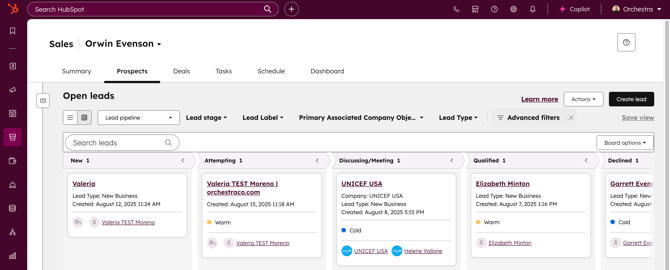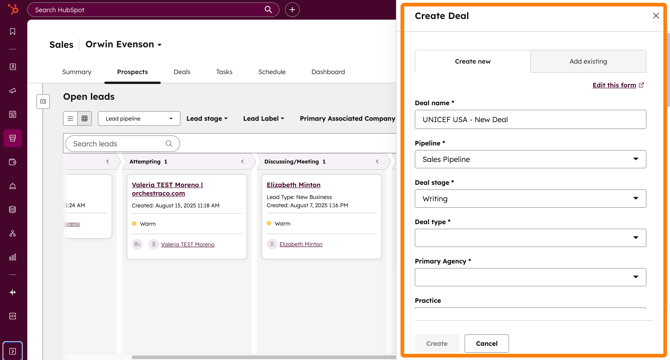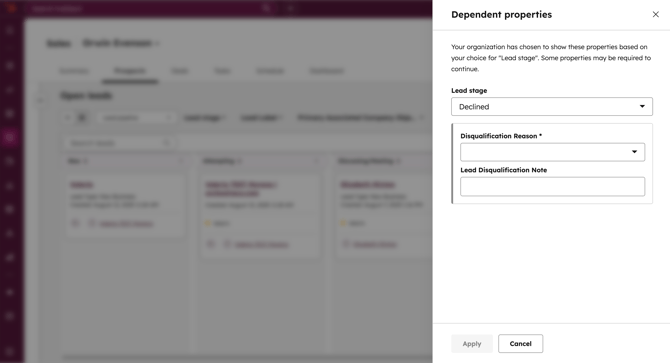Understanding the Lead Pipeline
Learn how Orchestra qualifies leads in HubSpot, from first contact through qualification, and when to move opportunities forward into the Deals Pipeline.
The Lead Pipeline is where Orchestra evaluates whether a Sales Qualified Lead (SQL) is ready to become a Deal. It’s the bridge between early interest and a fully qualified opportunity. Business Development Representatives (BDRs) use this pipeline to track outreach, conversations, and qualification.
Lead Pipeline Stages
| Stage | Definition | Probability |
|---|---|---|
| New | Fresh lead assigned to a BDR; no contact attempted yet. All “Work with Us” form submissions enter here. | 0% |
| Attempting | BDR is actively trying to reach the lead; no two-way conversation yet. | 0% |
| Discussing/Meeting | Active dialogue is underway via email OR a meeting has been scheduled. | 0% |
| Declined | Lead is not a fit (budget, scope, services mismatch) OR the lead declines to continue. | 0% |
| Qualified | Confirmed opportunity with budget, timeline, and decision-maker. At this stage, a Deal is created. | 0% |
You can access your Lead Pipeline under the "Prospects" tab of the Sales Workspace.

How the Lead Pipeline Works
-
Leads enter at “New” — usually from web form submissions or assigned outreach lists.
-
Any contact who is assigned to the lifecycle stage "Lead" will appear in the Lead Pipeline for the Lead Owner. By default, the Lead Owner is the same as the Contact Owner.
-
-
Lead owners progress leads through Attempting → Discussing/Meeting as outreach occurs.
-
Leads may stay in this stage for years if necessary as we work relationships towards a potential deal. While you're meeting with, sending emails to, having coffees with, and even sending a capes deck to a lead, they can stay in this stage until a potential deal presents itself.
-
-
If a lead is not a fit, move to Declined — this helps keep the pipeline clean and accurate. For more guidance on declined reasons, see below or read the Declining Leads article here.
-
When a lead is Qualified, create a Deal. When you move a lead to the Qualified stage of the Lead Pipeline, HubSpot will prompt you to create a deal. If you do not create a deal here, then the lead will return to the previous stage.

Logging and Tracking Declined Leads
Not every lead will move forward — and that’s okay. Tracking Declined work accurately helps Orchestra understand why opportunities don’t progress and ensures our pipeline reflects reality.
When moving a lead to Declined, always select the most accurate Decline Reason:
| Decline Reason | Definition / Example |
|---|---|
| Insufficient Budget | Client’s budget too low for quality work delivery. |
| Industry/Issue Area Knowledge | Lack of knowledge or expertise in the client’s industry. |
| Outside Capabilities | Services requested fall outside Orchestra’s offerings. |
| Capacity/Timing | Team unavailable during client’s required timeline. |
| Poor Fit Signals |
Red flags about expectations, process, or culture. For example, unrealistic review cycles, off-hours demands. |
| Values Mismatch |
Work conflicts with Orchestra’s values For example, we never work with tobacco companies. |
| Lead Declined |
Prospect chose not to continue or stopped responding. Inactive or unresponsive leads will be removed after 90 days unless placed on Hold. |
| Client Conflict | Opportunity conflicts with an existing Orchestra client. |
When moving a Lead to Declined you will be required to select a disqualification reason. If you do not, the lead will not be declined. You may add any other note to the record to explain the disqualification reason.

Best Practices for Declined Leads
-
Always choose the closest matching reason — this data is used for reporting and strategy.
-
Add a short note with context if needed (e.g., “Client confirmed $5k max budget”).
-
If unsure which reason applies, ask #HubSpot before closing.